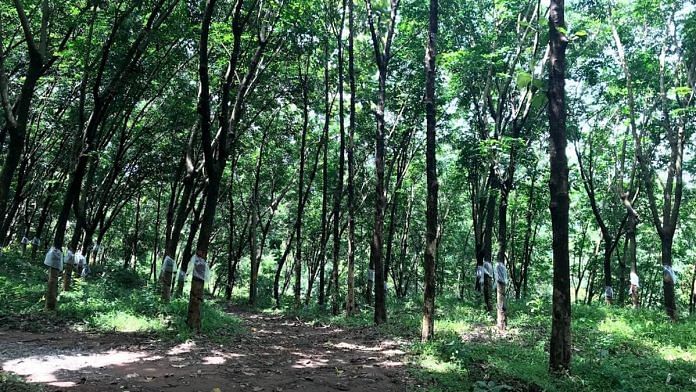New Delhi: In what could be termed as a major breakthrough in rubber cultivation across the country, the world’s first genetically modified (GM) rubber plant has been planted at the Rubber Board’s Sarutari research farm on the outskirts of Guwahati in Assam.
The GM rubber plant has been developed by Kerala-based Rubber Research Institute of India (RRII), which comes under the Rubber Board supervised by the Union Ministry of Commerce and Industry.
The GM rubber sapling, said to be world’s first, has been modified by inserting additional copies of the gene MnSOD (manganese-containing superoxide dismutase). This gene enables the newly developed rubber plant to tide over extreme climatic stress such as hot and cold temperatures, along with drought-like conditions, according to experts.
The new crop is expected to cut short the maturity period of rubber, indicating chances for an early yield.
This will provide a further boost to the production of the crop in the northeastern region of the country, since natural rubber is a native of warm humid Amazon forests and is not naturally suited for colder conditions in the Northeast, though the region already accounts for most of the rubber production in India.
The development of GM rubber is essential to allow non-traditional rubber states such as Assam and Mizoram to further increase their production.
Also read: Amul turns to Lord Krishna, Goumata to counter PETA & hail India’s cultural links with milk
How the new crop will improve growth
According to Rubber Research Institute of India Director James Jacob, the MnSOD gene removes toxic oxygen in plants caused by extreme temperatures such as heat or harsh winter, as is the case in Northeast, which inhibits growth.
“Natural rubber is native to Amazon, isn’t adapted to the Northeast but it’s being grown there with a price as there is retardation in the growth of young rubber crop due to extreme winter climate when temperature dips to as low as 10 degrees Celsius. Therefore maturity time in the Northeast is longer than in Kerala which is a comparatively tropical region,” he said.
Jacob said rubber plants in Kerala become ready for tapping in the seventh year, while it takes more than eight years in the Northeast.
“With the new GM crop, we are expecting the growth in winter times in Northeast at par to normal plant growing levels in Kerala, thereby reducing the maturity level by one year. We have also applied to conduct field trials in Maharashtra where we can test the crop in harsh summer temperatures of over 40 degrees Celsius,” he said.
Jacob added that it will take a couple of years to assess the result of the field trial of GM rubber crop, with the initial results expected to start coming in the winter months of December to January.
Experts behind the development of the new GM rubber say the growth of young rubber remains suspended during the winter months, which are also characterised by progressive drying of the soil. This is why the crop takes longer to mature in Northeast.
The MnSOD gene has the ability to protect plants from the adverse effects of severe environmental stress such as cold or drought.
Also read: Swadeshi push, no flash sales: How draft e-commerce rules will impact Amazon, Flipkart, others
Scale of project
According to reports, the Rubber Board has taken the initiative to plant rubber in 2 lakh hectares in the Northeast as part of a Rs 1,100-crore five-year project taken up by the Automotive Tyre Manufacturers’ Association (ATMA).
While the cultivation started on a limited scale this month, the full project will begin with 10,000 hectares in the first year of the cultivation.
To extend the field trial of GM rubber, ATMA will also extend financial support on a basis of Rs 50,000/hectare by a credit-linked scheme or by direct payment for planting materials. The materials will mainly be sourced from nurseries in Kerala where the RRII is based (in Kottayam).
However, the final release of the new GM crop for commercial cultivation will only begin after a successful completion of the proposed field trials, which are expected to take at least 10-15 years along with other necessary approvals.
The long journey to fruition
The field trials of GM rubber finally saw the light of day after a delay of over a decade as the Kerala government had opposed the project, citing its possible adverse impact on the environment and “agro-biodiversity”.
Reports show that the Genetic Engineering Appraisal Committee had permitted field trials of GM rubber in Kottayam in 2010 only. However, the then LDF government had denied approval, with agriculture minister Mullakkara Ratnakaran requesting to the Centre to revoke the approval stating that the state wanted to remain free of GM crops.
This led to a major setback in the development of the GM rubber crop as natural rubber accounts for over 20 per cent of Kerala’s total area under cultivation and contributes the largest share of over 84 per cent of the country’s output. It is followed by Karnataka, Tamil Nadu, and the northeastern states of Assam, Tripura and Meghalaya.
However, Rubber Board Chairman and Executive Director K.N. Raghavan, while speaking to media on the planting the world’s first GM rubber sapling, said: “MnSOD gene used in the GM rubber was taken from the rubber plant itself. Its copies were multiplied in the laboratory and reinserted into a cell of the rubber plant which was then regenerated into a full plant that is now planted in the field.”
He added, “There are no plant species in India that can breed with natural rubber. Therefore, there is no risk of genes flowing from the GM rubber into any other native species, a concern often raised by environmental groups against GM plants in general.”
Also read: Black rice, the ‘forbidden’ grain that earned UP’s Chandauli big UNDP praise and good profit



